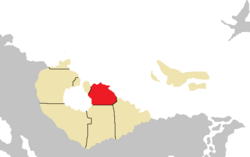Province of Kievits Hoek
This article is incomplete because it is pending further input from participants, or it is a work-in-progress by one author. Please comment on this article's talk page to share your input, comments and questions. Note: To contribute to this article, you may need to seek help from the author(s) of this page. |
Kievits Hook
Provincie van Kievits Hook | |
|---|---|
Province | |
| Province of Kievits Hook | |
| Nickname: The Oceangoing Province | |
| Motto(s): "Wees Waakzaam"
"Be Alert" | |
 The province of Kievits Hook, in dark red. | |
| Country | Federal Republic of Rensselaerswijck |
| Admitted | 1820 |
| Counties | List of Counties
|
| Government | |
| • Governor | Eduard Vanderwouden II (Liberal Democratic) |
| • Deputy Governor | Rombert Van Duyne |
| • Cabinet |
|
| Population (1930 Census) | |
| • Total | 522,459 |
| • Rank | 2nd (Rensselaerswijck) |
| Provincial Assembly | Assembly Layout
|
The Province of Kievits Hoek (Freijian: Provincie van Kievits Hoek) is a Rensselaer province located in central Rensselaerswijck. It is bordered by the province of Nieuw Hoop to the west, the province of Vrystaat to the south, and the province of Wilhelmnus to the east. Kievits Hoek is the second-most populous province in the country, and is the country's hub for shipbuilding and military naval construction. The province is dotted mainly by large towns and cities, and is one of the most developed provinces in the country.
Kievits Hook is the stronghold for the Liberal Democratic Party, with a soft-middle class base not as tied to the mercantilist appeal in Nieuw Hoop. It has consistently voted for Liberal Democratic candidates over its electoral history, excluding the 1928 Snap Elections, in which the province voted for Willem Lodewijk for president. It was the first and only time the majority of the province voted for a Mercantile Interest presidential candidate.
The provinces of Kievits Hoek, Nieuw Hoop, and Wilhelmnus all form the "urban-belt" of the country, consisting of upwards of 70% of the population and having all of the top ten biggest cities in the country. It is within this urban-belt that the province experiences rapid economic growth. The population of the province is expected to multiply in coming decades, due in part to many moving into the urban-belt from rural Rensselaerswjick. Many analysts predict that a result of an influx of new citizens to cities like Nieuw Hoop or Volendam is that some will leave the big cities for less-dense while still city life in provinces such as Kievits Hoek.
Kievits Hoek is one of the least diverse provinces in the country, having nearly 85% of her citizens identify with some sort of ancestry with Freijian or mainland Cybelleum. The lowest population of indigenous citizens in the country are recorded here, only 10% identifying as "native or indigenous."
The name Kievits Hoek roughly translates to "Plover's Corner," and the area around the province used to be a breadbasket for farming in the early days of colonial Rensselaerswjick. Flat, coastal plain allowed for easy settlement, which explains why it is now part of the "urban-belt." As colonists headed deeper into Rensselaerswjick, they found even more fertile plains than Kievits Hoek, leading it to be abandoned as a place of farming. While a small agricultural industry does exist in border regions of the province, they pale in comparison to the agricultural economies of Wilhelmnus and Vrystaat.
